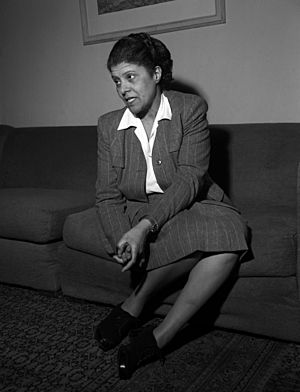Eslanda Goode Robeson facts for kids
Quick facts for kids
Eslanda Goode Robeson
|
|
|---|---|

Eslanda Robeson, c. 1947
|
|
| Born | December 15, 1895 Washington, D.C., U.S.
|
| Died | December 13, 1965 (aged 69) New York City, New York, U.S.
|
| Education | University of Illinois, Urbana-Champaign Columbia University (BS) London School of Economics (MS) Hartford Seminary (PhD) |
| Spouse(s) | |
| Children | Paul Robeson Jr. |
| Scientific career | |
| Fields | Anthropology |
| Institutions | New York-Presbyterian Hospital |
Eslanda "Essie" Cardozo Goode Robeson (December 15, 1895 – December 13, 1965) was an important American anthropologist, author, actress, and civil rights activist. She was also the wife and business manager of the famous performer Paul Robeson. Eslanda was known for her strong beliefs in equality and her work to support people of color around the world.
Contents
Eslanda Robeson's Life Story
Early Life and Education
Eslanda Cardozo Goode was born in Washington, D.C., on December 15, 1895. Her family had a rich history; her ancestors included enslaved Africans and a Sephardic Jewish family from Spain. Her maternal grandfather, Francis Lewis Cardozo, was a very important person, becoming the first black secretary of state in South Carolina. Her father, John Goode, worked in the War Department and later became a lawyer.
Eslanda was a bright student. She attended the University of Illinois and then graduated from Columbia University in New York with a degree in chemistry. While at Columbia, she became very interested in fighting for racial equality. She also started working at New York-Presbyterian Hospital, where she quickly became the head chemist in surgical pathology. She was the first black person to hold such a high position there.
Marriage and Early Career
In 1920, Eslanda met Paul Robeson at Columbia University. They married a year later in August 1921. Eslanda decided to put her plans to study medicine on hold to support Paul's career. She became his business manager and helped him become a successful actor and singer. Paul even said that Eslanda was the reason he started acting! She continued working at the hospital until 1925, when Paul's career became so busy that it needed all her time. They spent time living in Harlem, London, and France.
Eslanda and Paul had one child, Paul Jr., who was born on November 2, 1927. Even though their marriage faced challenges, Eslanda chose to focus on her own goals and stay married to Paul.
In the late 1920s, Eslanda wrote her first book, a biography about her husband called Paul Robeson, Negro. It was published in 1930. Some critics, like Harry Hanson, praised the book, saying it was inspiring and showed her deep understanding. W.E.B. Du Bois, a famous civil rights leader, even said it was a "must read."
Eslanda also acted in a silent film called Borderline in 1930, playing a character named Adah.
Becoming an Anthropologist
In 1931, while living in London, Eslanda decided to focus more on her own career. She took on acting roles in three movies. She also enrolled at the London School of Economics to study anthropology, which is the study of human societies and cultures. She graduated in 1937.
Her studies in England sparked a deep interest in Africa. In 1936, she made her first trip to the continent, traveling through South and East Africa with her son. As World War II approached, the Robesons moved back to Harlem in 1938, and later to their home in Connecticut.
Eslanda continued her education and earned her Ph.D. in anthropology from the Hartford Seminary in 1946. That same year, she published her second book, African Journey. This book was special because it offered a unique view of Africa, especially about women, from the perspective of an African American woman. The book encouraged black people to be proud of their African heritage and received positive reviews.
Eslanda also worked with author Pearl Buck to publish American Argument in 1949. This book featured conversations and ideas from Eslanda about society, politics, gender roles, and race relations.
Activism During the Cold War
The Cold War was a time of tension between the United States and the Soviet Union. During this period, Eslanda and Paul Robeson's lives changed a lot. They had visited the Soviet Union in 1934 and were impressed by what they saw as a lack of racism there. They agreed with the Soviet Union's stance against racism and colonization.
In 1941, Eslanda and Paul helped start the Council on African Affairs. As a member, Eslanda often spoke out against Western countries for controlling people of color for their own political and economic gain.
During the time of McCarthyism in the U.S., when people were often suspected of being communists, the Robesons faced difficulties. Paul's passport was taken away, which made it hard for him to work, and their income dropped. On July 17, 1953, Eslanda was called to testify before the U.S. Senate. When asked if she was a communist, she used her right to remain silent under the Fifth Amendment and questioned the fairness of the hearing. Her passport was also taken away until 1958.
Despite these challenges, Eslanda continued to work for the Council on African Affairs and wrote for the New World Review, a magazine that supported the Soviet Union. She fought for the independence of countries in Africa and Asia from colonial rule.
Once their passports were returned in 1958, the Robesons traveled to London and the Soviet Union. Eslanda made her third and final trip to Africa, attending an important conference in Ghana for newly independent African nations. In 1963, she was diagnosed with breast cancer. She returned to the U.S. from Russia and passed away in New York in 1965, just two days before her 70th birthday.
Awards and Honors
- Clara Zetkin Medal (Clara-Zetkin-Medaille), GDR

